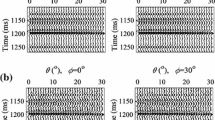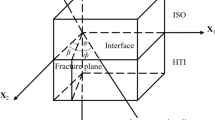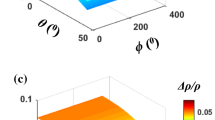Abstract
Underground fractures play an important role in the storage and movement of hydrocarbon fluid. Fracture rock physics has been the useful bridge between fracture parameters and seismic response. In this paper, we aim to use seismic data to predict subsurface fractures based on rock physics. We begin with the construction of fracture rock physics model. Using the model, we may estimate P-wave velocity, S-wave velocity and fracture rock physics parameters. Then we derive a new approximate formula for the analysis of the relationship between fracture rock physics parameters and seismic response, and we also propose the method which uses seismic data to invert the elastic and rock physics parameters of fractured rock. We end with the method verification, which includes using well-logging data to confirm the reliability of fracture rock physics effective model and utilizing real seismic data to validate the applicability of the inversion method. Tests show that the fracture rock physics effective model may be used to estimate velocities and fracture rock physics parameters reliably, and the inversion method is resultful even when the seismic data is added with random noise. Real data test also indicates the inversion method can be applied into the estimation of the elastic and fracture weaknesses parameters in the target area.
Similar content being viewed by others
References
Bachrach R, Sengupta M, Salama A, et al. 2009. Reconstruction of the layer anisotropic elastic parameter and high resolution fracture characterization from P-wave data: A case study using seismic inversion and Bayesian rock physics parameter estimation. Geophys Prospect, 57: 253–262
Bakulin A, Grechka V, Tsvankin I. 2000. Estimation of fracture parameters from reflection seismic data—Part I: HTI model due to a single fracture set. Geophysics, 65: 1788–1802
Batzle M, Han D H, Castagna J. 1999. Fluids and frequency dependent seismic velocity of rocks. Seg Tech Prog Exp Abs, 18: 5–8
Batzle M, Han D H, Hofmann R. 2006. Fluid mobility and frequency-dependent seismic velocity—Direct measurements. Geophysics, 71: N1–N9
Biot M A. 1956a. Theory of propagation of elastic waves in a fluid saturated porous solid: A. Low-frequency range. J Acoust Soc Am, 28: 168–179
Biot M A. 1956b. Theory of propagation of elastic waves in a fluid saturated porous solid. B. Higher frequency range. J Acoust Soc Am, 28: 170–191
Brown R, Korringa J. 1975. On the dependence of the elastic properties of a porous rock on the compressibility of the pore fluid. Geophysics, 40: 608–616
Chapman M. 2009. Modeling the effect of multiple sets of mesoscale fractures in porous rock on frequency-dependent anisotropy. Geophysics, 74: D97–D103
Cheng C H. 1978. Seismic velocities in porous rocks: Direct and inverse problems. Doctoral Dissertation. Massachusetts: Massachusetts Institute of Technology
Cheng C H. 1993. Crack models for a transversely anisotropic medium. J Geophys Res, 98: 675–684
Downton J. 2005. oSeismic parameter estimation from AVO inversion. Doctoral Dissertation. Alberta: University of Calgary
Downton J, Gray D. 2006. AVAZ parameter uncertainty estimation. Seg Tech Prog Exp Abs, 25: 234–238
Gassmann F. 1951. Uber die elastizitat poroser medien. Vierteljahrsschrift Naturforschenden Gesellschaft Zurich, 96: 1–23
Gurevich B. 2003. Elastic properties of saturated porous rocks with aligned fractures. J Appl Geophys, 54: 203–218
Hill R. 1952. The elastic behavior of crystalline aggregate. Proc Phys Soc, 65: 349–354
Huang L, Jiang T, Omoboya B, et al. 2013. Fluid substitution for an HTI medium. Seg Tech Prog Exp Abs, 32: 2659–2663
Hudson J A. 1981. Wave speeds and attenuation of elastic waves in material containing cracks. Geophys J R Astr Soc, 64: 133–150
Liu E, Martinez A. 2012. Seismic fracture characterization. Netherlands: EAGE Publication
Mallick S, Craft K L, Meister L J, et al. 1998. Determination of the principal directions of azimuthal anisotropy from P-wave seismic data. Geophysics, 63: 692–706
Mavko G, Mukerji T, Dvorkin J. 2009. The Rock Physics Handbook. Cambridge: Cambridge University press.
Quintal B, Schmalholz S M, Podladchikov Y. 2010a. Impact of fluid saturation on the reflection coefficient of a poroelastic layer. Seg Tech Prog Exp Abs, 29: 2730–2735
Quintal B, Steeb H, Frehner M, et al. 2010b. Finite element modeling of seismic attenuation due to fluid flow in partially saturated rocks. Seg Tech Prog Exp Abs, 29: 2564–2569
Quintal B, Schmalholz S M, Podladchikov Y. 2011. Impact of fluid saturation on the reflection coefficient of a poroelastic layer. Geophysics, 76: N1–N12
Quintal B, Steeb H, Frehner M, et al. 2012. Pore fluid effects on S-wave attenuation caused by wave-induced fluid flow. Geophysics, 77: L13–L23
Rüger A. 1996. Reflection coefficient and azimuthal AVO analysis in anisotropic media. Doctoral Dissertation. Colorado: Colorado School of Mines
Rüger A. 1997. P-wave reflection coefficients for transversely isotropic models with vertical and horizontal axis of symmetry. Geophysics, 62: 713–722
Rüger A. 1998. Variation of P-wave reflectivity with offset and azimuth in anisotropic media. Geophysics, 63: 935–947
Sa L M, Yao F C, Di B R, et al. 2011. Seismic response characteristics and identification method of fracture-cavity reservoir (in Chinese). Litholog Reserv, 23: 23–28
Schoenberg M. 1980. Elastic wave behavior across linear slip interface. J Acoust Soc Amer, 68: 1516–1521
Schoenberg M, Douma J. 1988. Elastic wave propagation in media with parallel fractures and aligned cracks. Geophys Prospect, 36: 571–590
Schoenberg M, Helbig K. 1997. Orthorhombic media: Modeling elastic wave behavior in a vertically fractured earth. Geophysics, 62: 1954–1974
Schoenberg M, Muirt F. 1989. A calculus for finely layered anisotropic media. Geophysics, 54: 581–589
Schoenberg M, Protazio J. 1992. ‘Zoeppritz’ rationalized and generalized to anisotropy. J Seis Expl, 1: 125–144
Schoenberg M, Sayers C M. 1995. Seismic anisotropy of fractured rock. Geophysics, 60: 204–211
Tang W B, Liu L X, Fan G, et al. 2002. Analytic technique of frequency difference for discrimination of cavity fillers (in Chinese). Oil Gas Geol, 23: 41–44
Tang X M. 2011. A unified theory for elastic wave propagation through porous media containing cracks-An extension of Biot’s poroelastic wave theory. Sci China Earth Sci, 54: 1441–1452
Thomsen L. 1986. Weak elastic anisotropy. Geophysics, 51: 1954–1966
Teng L. 1998. Seismic and rock physics characterization of fractured reservoirs. Doctoral Dissertation. California: Stanford University
Wood A W. 1955. A Textbook of Sound. New York: McMillan Co
Yao Y, Tang W B. 2003. Theoretical study of detectable cavern-fractured reservoir in weathered Karst of deep carbonate (in Chinese). Oil Geol Prospec, 38: 623–629
Yao Y, Tang W B, Xi X, et al. 2012. Wave field analysis and recognition method of cave reservoir based on numerical simulation (in Chinese). Litholog Reserv, 24: 1–6
Yang W C. 1997. Theory and Methods of Geophysical Inversion (in Chinese). Beijing: Geological Publishing House
Zimmerman R W. 1991. Elastic moduli of a solid containing spherical inclusions. Mech Mater, 12: 17–24
Zhang G Z, Chen H Z, Wang Q, et al. 2013. Estimation of S-wave velocity and anisotropic parameters using fractured carbonate rock physics model (in Chinese). Chin J Geophys, 56: 1707–1715
Author information
Authors and Affiliations
Corresponding author
Rights and permissions
About this article
Cite this article
Chen, H., Yin, X., Gao, J. et al. Seismic inversion for underground fractures detection based on effective anisotropy and fluid substitution. Sci. China Earth Sci. 58, 805–814 (2015). https://doi.org/10.1007/s11430-014-5022-1
Received:
Accepted:
Published:
Issue Date:
DOI: https://doi.org/10.1007/s11430-014-5022-1




